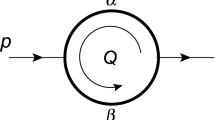Abstract
We build high order efficient numerical integration methods for solving the linear differential equation \(\dot X\) = A(t)X based on the Magnus expansion. These methods preserve qualitative geometric properties of the exact solution and involve the use of single integrals and fewer commutators than previously published schemes. Sixth- and eighth-order numerical algorithms with automatic step size control are constructed explicitly. The analysis is carried out by using the theory of free Lie algebras.
Similar content being viewed by others
REFERENCES
M. A. Abramowitz and I. A. Stegun, Handbook of Mathematical Functions, Dover, New York, 1965.
S. Blanes, F. Casas, J. A. Oteo, and J. Ros, Magnus and Fer expansions for matrix differential equations: the convergence problem, J. Phys. A: Math. Gen., 31(1998), pp. 259–268.
S. Blanes, Estudio de la evoluci´on de sistemas din´amicos cl´asicos y cu´anticos utilizando m´etodos algebraicos, Ph.D. thesis, Universitat de Val`encia, 1998.
S. Blanes, F. Casas, and J. Ros, High order integration algorithms based on Magnus expansion, preprint (1998).
S. Blanes and P. C. Moan, Splitting methods for the time-dependent Schrüdinger equation, Phys. Lett. A, 265(2000), pp. 35–42.
P. J. Channell and F. R. Neri, An introduction to symplectic integrators, in Integration Algorithms and Classical Mechanics, J. E. Marsden, G. W. Patrick, and W. F. Shadwick, eds., American Mathematical Society, Providence, RI, 1996, pp. 45–58.
E. Celledoni and A. Iserles, Approximating the exponential from a Lie algebra to a Lie group, DAMTP Tech. Report 1998/NA3, University of Cambridge, 1998.
L. Dieci, R. D. Russell, and E. S. Van Vleck, Unitary integrators and applications to continuous orthonormalization techniques, SIAM J. Numer. Anal., 31(1994), pp. 261–281.
G. H. Golub and C. F. Van Loan, Matrix Computations, 2nd ed., The Johns Hopkins University Press, Baltimore, MD, 1989.
E. Hairer, S. P. Nørsett, and G. Wanner, Solving Ordinary Differential Equations, 2nd ed., Springer-Verlag, Berlin, 1993.
R. W. Hamming, Numerical Methods for Scientists and Engineers, 2nd ed., Dover, New York, 1986.
A. Iserles and S. P. Nørsett, On the solution of linear differential equations in Lie groups, Philos. Trans. Royal Soc. A, 357(1999), pp. 983–1019.
A. Iserles, A. Marthinsen, and S. P. Nørsett, On the implementation of the method of Magnus series for linear differential equations, BIT, 39(1999), pp. 281–304.
A. Iserles, S. P. Nørsett, and A. F. Rasmussen, Time-symmetry and high-order Magnus methods, DAMTP Tech. Report 1998/NA06, University of Cambridge, 1998.
S. Klarsfeld and J. A. Oteo, Recursive generation of higher-order terms in the Magnus expansion, Phys. Rev. A, 39(1989), pp. 3270–3273.
W. Magnus, On the exponential solution of differential equations for a linear operator, Commun. Pure Appl. Math., 7(1954), pp. 649–673.
K. F. Milfeld and R. E. Wyatt, Study, extension and application of Floquet theory for quantum molecular systems in an oscillating field, Phys. Rev. A, 27(1983), pp. 72–94.
P. C. Moan, Efficient approximation of Sturm–Liouville problems using Lie-group methods, DAMTP Tech. Report 1998/NA11, University of Cambridge, 1998.
C. Moler and C. F. Van Loan, Nineteen dubious ways to compute the exponential of a matrix, SIAM Rev., 20(1978), pp. 801–836.
H. Munthe-Kaas and B. Owren, Computations in a free Lie algebra, Philos. Trans. Royal Soc. A, 357(1999), pp. 957–981.
P. Pechukas and J. C. Light, On the exponential form of time-displacement operators in quantum mechanics, J. Chem. Phys., 44(1966), pp. 3897–3912.
D. Prato and P. W. Lamberti, A note on Magnus formula, J. Chem. Phys., 106 (1997), pp. 4640–4643.
J. M. Sanz-Serna and M. P. Calvo, Numerical Hamiltonian Problems, Chapman & Hall, London, 1994.
R. M. Wilcox, Exponential operators and parameter differentiation in quantum physics, J. Math. Phys., 8(1967), pp. 962–982.
Author information
Authors and Affiliations
Rights and permissions
About this article
Cite this article
Blanes, S., Casas, F. & Ros, J. Improved High Order Integrators Based on the Magnus Expansion. BIT Numerical Mathematics 40, 434–450 (2000). https://doi.org/10.1023/A:1022311628317
Issue Date:
DOI: https://doi.org/10.1023/A:1022311628317




